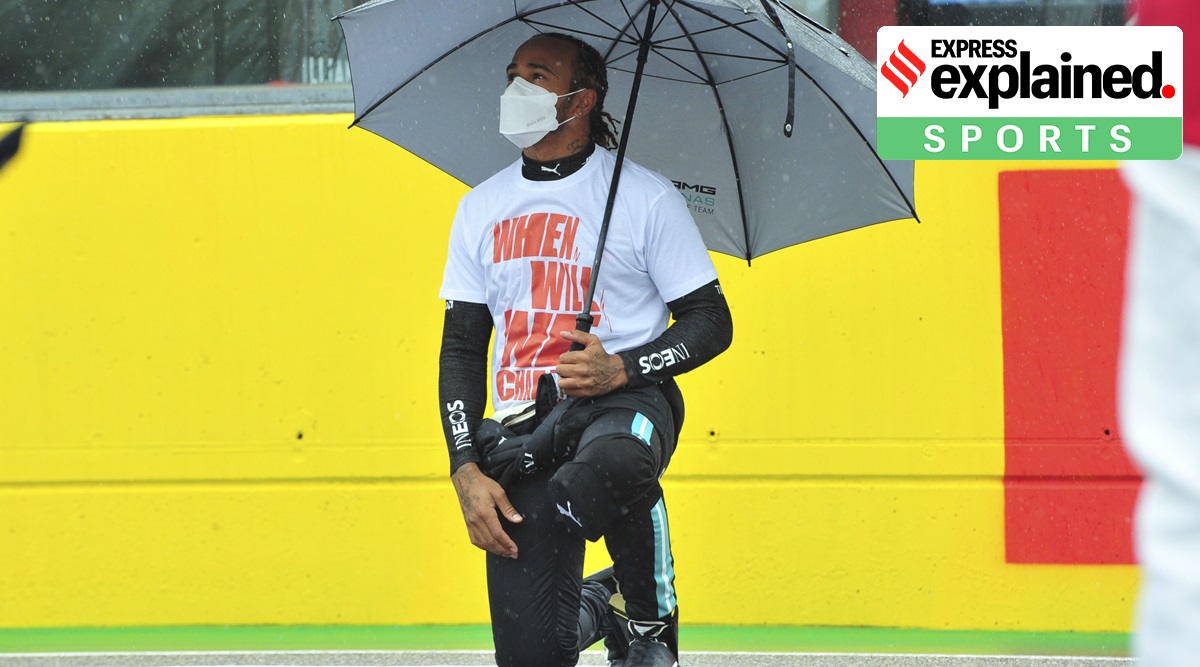Article 50: Why IOC chose to continue ban on protests on field, podiums

This week, Olympic-bound athletes will know the rules and restrictions to be imposed on them during their stay in Tokyo. While they await that, and amidst the uncertainty over the Games themselves, one stipulation has been made clear: they won’t be allowed to protest on the field, on podiums, and during ceremonies. The decision, taken on the back of the International Olympic Committee’s (IOC’s) Rule 50, has triggered a fresh round of debate over athletes’ right to expression.
The IOC’s Rule 50 forbids any kind of “demonstration or political, religious or racial propaganda” at venues and any other Olympic area.
Newsletter | Click to get the day’s best explainers in your inbox
However, following the death of George Floyd in the USA last May, which triggered anti-racism protests and gave a boost to the Black Lives Matter movement, the Olympic body came under pressure to relax the rule so that athletes could express themselves freely during the Games.
Subsequently, the IOC’s Athletes Commission started a consultation process in June last year, took views from 3,547 athletes before last week, it was recommended that the rule should be maintained.
Field of play ‘sacrosanct’
According to the survey, 70 per cent of the surveyed athletes felt the field of play and official ceremonies were not an appropriate place for competitors to demonstrate. Almost 67 per cent said they weren’t in favour of podium protests.
Former shooter and Olympic gold medallist Abhinav Bindra, who is a member of the Athletes Commission, said the process was ‘open and transparent.’ “The biggest takeaway was that an overwhelming number of athletes still would like to see that the field of play and the ceremonies remain sacrosanct, and they are kept away from any protests,” Bindra told The Indian Express.
The athletes, the recommendations added, will continue to have other opportunities to express themselves: in press conferences, on social media, in mixed zones, and there is also a suggestion to ‘increase athletes’ expression outside the Olympic Games’.
But the Olympic Village, ceremonies, and field of play, Bindra said, were important to preserve. “The greatest degree of solidarity lies in an Olympic Village, where you have 206 National Olympic Committees and an Olympic refugee team living together peacefully in one place. It is such a great example for the world and for society in general,” he said.
“Hence, there is an emphasis on the need to preserve (those areas) since this can also snowball into something very dangerous. You also have nations where athletes could be forced to protest in a certain way, whether they agree to a certain aspect or not. So, one has to be very, very careful.”
Contradicting views
The debate over the issue has laid bare contradicting views among athletes and officials. Last year, when Sebastian Coe chose Tommie Smith, Peter Norman and John Carlos – the trio on the podium at the 1968 Olympics when Smith and Carlos made the Black Power salute – to receive the World Athletics President’s award, many saw it as the Briton’s support for podium protests at the Tokyo Games.
Eve the US Olympic and Paralympic Committee allowed American athletes to ‘raise their fists on the podium, kneel during the national anthem or wear a face mask that reads Black Lives Matter’, according to The Washington Post.
Britain’s track cycling gold medallist Callum Skinner told The Times that ‘standing up for equality was not a political act.’ “If one athlete wants to take a knee, they will take a knee,” Skinner said.
Skinner, now retired, is part of the Global Athlete group, which represents the athlete’s voice. Last August, the body’s director general Rob Koehler told The Indian Express that to give athletes space to demonstrate outside the field of play and ceremonies was ‘not enough.’ “An athlete trains for the 10 years of his or her life, athletes make very little money if any. And if they get to the podium one day and want to use it for what they believe in as a mechanism for social change, they should be allowed to do it,” Koehler had said.
Bindra said the Athletes Commission understood the other viewpoint, but had to ‘see the larger picture and uphold the values.’ “We will keep listening to this minority who want increased opportunities to express themselves at the Olympic Games because they are important,” he said.
Sanctions
While it will be known only in July-August, when the Games take place, whether any athletes will go against the recommendations and protests in the prohibited areas, it is still to be determined what kind of sanctions will be imposed on those who violate Rule 50.
Bindra said it is for the legal commission of the IOC to provide “clarity on the sanctions and intervene in a very quick manner.” But in a rapidly-evolving society amid contrasting viewpoints among athletes, the Indian said “nothing can ever be set in stone.”
“We’re always evolving. People are always evolving in mindsets and organisations also have to remain true and relevant,” Bindra said. “What has been recommended is for the time being. We will see how things evolve over a period of time.”

“평생 사상가. 웹 광신자. 좀비 중독자. 커뮤니케이터. 창조자. 프리랜서 여행 애호가.”
